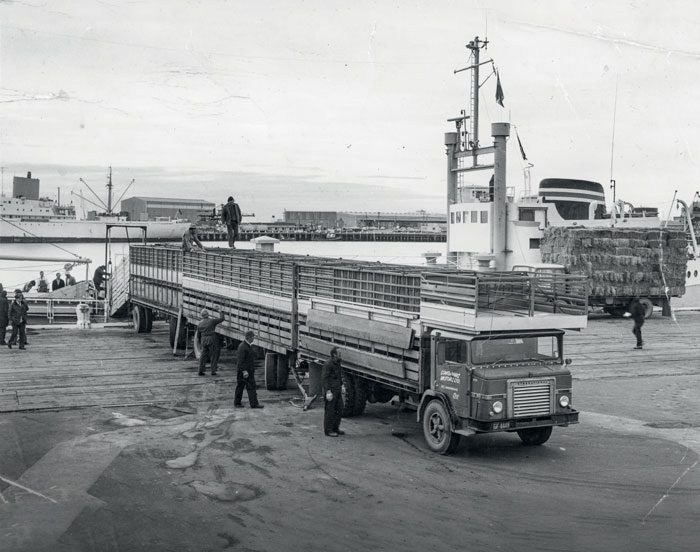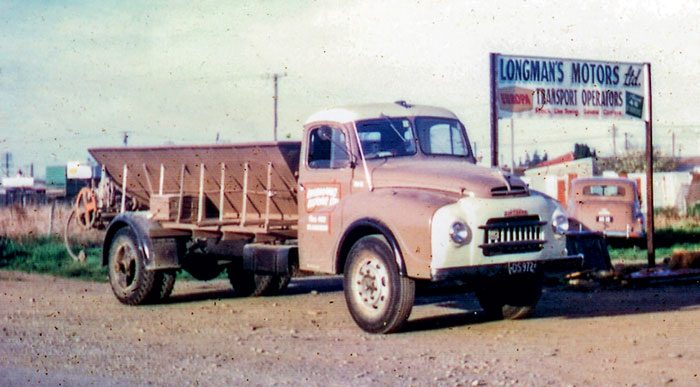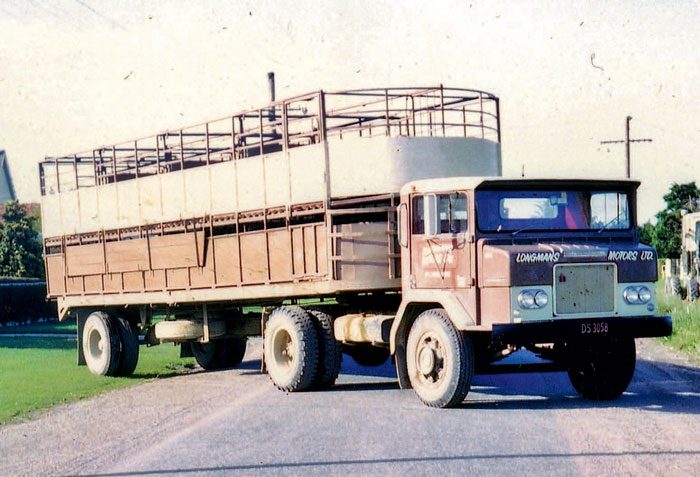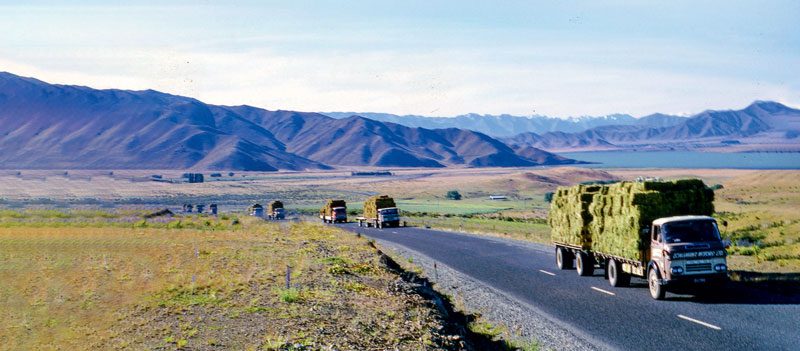Longman‘s Motors was an innovative South Canterbury Transport company that was one of the early players in long-distance livestock cartage.

Getting going
In 1965, three men wanted the challenge of owning a transport company. Hector ‘Hec‘ Cox, John Tiffen and Bryan Fowler bought Longman‘s Motors in St Andrews, south of Timaru, from Sandy McLaren. Before McLaren, Jack Slee from Bluff owned the company for three years after buying it from Wattie Longman, who had started the company in 1950. Hec was a farm manager but had driven trucks for Rollinson Motors from Albury between Cave and Fairlie on SH8. A claim to fame was driving the infamous ‘Queen Mary‘, an R190 International owned by the company. John was a mechanic/ engineer who worked at a local garage and had operated a D8 bully for the Waimate Lime Co (the same dozer that today resides beside SH1 between Herbert and Maheno, advertising books for sale). Bryan was a carpenter on the Lyttelton Wharf, although his father ran Makikihi Transport at the time. The first depot was in Thackeray Street, and the fleet consisted of five trucks, all British built. There were two 701 Morris trucks, an S Bedford, a Commer, and a WEK Austin 120. The Austin was a spreader “when the bonnet wasn‘t up,” said Hec. The British trucks were not great, although like most operators of the time the men worked the light trucks well above their limits. John recalls repairing the Austin and then taking it for a test drive, only for it to break its crankshaft. Work for Longman‘s was largely centred around the rural sector. There was a contract to Canterbury Frozen Meat carting salt, wool, and hides out of Timaru, plus delivering groceries to local stores. Hec did a bit of driving but was mostly in the office, John was mostly in the workshop, and Bryan drove fulltime.

Photo: The WEK Austin spreader (rare pic with the bonnet down).
Early on one of the Morris 701s gave way to a new petrol-powered Commer. It came to Longman‘s in its factory brown paint and they decided to add a splash of ivory to the brown. Up until then the trucks were a green colour, but this was now Longman‘s livery. The Commer went all right but received a transplanted motor in its life, as well as a transplanted cab following a rollover. John did all the work, and remembers pulling the motor out of it at Moonlight near Macraes in Central Otago and then taking it back home in his Vauxhall. British trucks still being the preferred choice, another new Commer joined the fleet, as did an A5 Bedford, the latter a tipper, again petrol-powered with a 214 cubic inch (3.5 litre) motor. It would carry 14 tons (14.2 tonnes) on a 12-ton (12.2 tonne) sticker carting grain to the rail, and then backloading coal and fertiliser, also from the rail, and all loaded by hand using an Atlas #2 ‘shovel‘ as John called it. A petrol-powered ACCO International came onboard new in 1967 when a truck was needed in a hurry. They had sent a Commer A-train away to take a load of stock from the Holme Station sale near Timaru to Kaiapoi (194km). Its motor gave up and it limped home in low gear. It was just worn out. Longman‘s needed a new truck overnight and W.E. Gander in Timaru could supply one. This was the first ACCO to go on the road in South Canterbury. It was an artic, often an A-train also, and “it could fly”, Hec recalls. It wasn‘t the end of Commers, though. A 4×2 equipped with a tag axle and powered by a Tilling-Stevens diesel engine joined the fleet, although it didn‘t last long on account of a habit of blowing turbos.

Photo: The first ACCO International on the road in South Canterbury.
Opportunity from adversity
The drought of 1969 hit South Canterbury hard. While it was a downside for the farmers, it had an upside for Longman‘s Motors. Load upon load of livestock was carted out of the area to freezing works, or for grazing on greener pastures. At the same time, they were also taking crates off and carting hay back into the droughtstricken area. On one day, Longman‘s organised 17 trucks to go down to Hawea Flat near Wanaka to bring hay back; 13 of theirs, plus four from other operators. Only one truck – and it wasn‘t a Longman‘s truck – lost the back tier of hay on the way home coming over the Lindis Pass. The drought made Longman‘s a lot of money and it was all spent buying new trucks. An order was placed for four new ACCO Internationals with 510 V8 Perkins motors in them. Three were put onto livestock cartage, and one was a spreader. Most of these C1800 Internationals would end up with owner-drivers. It was the early 70s and Bryan had left to work elsewhere. Still reaping the rewards of drought work, an opportunity arose to buy Millers Transport from Timaru. Hec wasn‘t interested in the trucks as such; they‘d been worked hard and were worn out with little maintenance, and again, were a lot of low-powered British trucks working well beyond their design brief. What Hec wanted were the distance licences and the depot, which Eric Miller retained, but Longman‘s leased from him.
 Hec Cox. With business partners John Tiffen and Bryan Fowler, demonstrated innovation and a willingness to explore opportunity. Something New Zealand needs in shovel-loads today.
Hec Cox. With business partners John Tiffen and Bryan Fowler, demonstrated innovation and a willingness to explore opportunity. Something New Zealand needs in shovel-loads today.
The purchase came with Millers‘ clients, so there was now plenty of work to keep Longman‘s busy. They now had 21 distance licences that could see them cart right down to Bluff. A few trucks were actually based there, including a tilt-cab ACCO tractor unit with a Hiab crane, and a couple of TK Bedfords with petrol motors among them. The trucks worked hard. Motors were lasting around 100,000km before needing a rebuild or replacement and there was a spare engine in the workshop ready to go into a truck when required. Taking pistons and compressors out of Commers was common, and although the Commers required a lot of work, John still loved the sound. When John wasn‘t repairing engines, he was building crates and trailers for the fleet, the company buying Sutton units when he couldn‘t keep up. Having outgrown the Thackeray Street depot the workshop was now in a new shed in a new yard beside SH1 in St Andrews. It was built by one of the drivers, a builder by trade who came onboard when Longman‘s bought Millers.

Photo: Three of Longman‘s Commers and the first ACCO International loaded with sheep, this time carting stock away from the drought.
Long haulin‘
As the lead distances increased, the company also fitted additional fuel capacity. The first was a petrol-powered ACCO with vacuum brakes running as an A-train on sheep cartage. At 28 ton (28.5 tonne) it carted as far south as the Ocean Beach freezing works in Bluff (415km one way). From St Andrews, it could get as far south as Clarkesville, just south of Milton (250km) to refuel, and then back to Gore for a refuel on its way home. Its 282 cubic inch (4.6 litre) petrol motor was eventually replaced with a 345 cubic inch (5.6 litre) petrol out of an ex Burnett‘s Transport International Loadstar, and it made the truck “very quick” said Hec. The second, another C1800, ran to Christchurch (163km) carting grain at 20 ton (20.3 tonne). Interestingly Burnetts, where the replacement motor for the stock unit came from, were replacing petrol motors with Detroit Diesels. Longman‘s was generally replacing petrol engines with bigger petrol engines, although a few Scania diesels had found their way into the business. At one stage the fleet would boast 14 International ACCOs. Only one 2150 ACCO ever made it into the fleet and it tested their loyalty to the brand with the dreaded 555 Cummins motor in it. “It couldn‘t go anywhere without breaking down,” Hec recalls. “It came home one Friday morning for a small fix, and it was still being fixed on Saturday afternoon.
It would just shake itself to bits.” It was so bad that Hec had dealer W.E. Gander take it back. Not all the trucks were bought new; secondhand units were purchased for the right application. A good example was a Mercedes-Benz 1418 with 700,000km on it, ideal for carting livestock to the works close by. The local Mercedes- Benz dealer had tried to sell Hec a new truck, but they were expensive at the time. Not giving the brand a go is something Hec regrets. “The Mercs weren‘t cheap but were known for being comfortable and reliable.” It was common on a Monday morning to see four fully loaded Longman‘s trucks heading to the Burnside freezing works in Dunedin with sheep. On one occasion one of the V8 Perkins-powered ACCOs met its fate at the bottom of Pine Hill on the city‘s northern entrance after cooking its brakes. The sheep that survived ended up among the Botanical Gardens and Hec had to get the shepherds from the freezing works to help round them up. That said, Longman‘s had very few accidents during its time. With the trucks now carting into Southland, they were also carting out of Southland, and this “Didn‘t impress the local carriers,” said Hec. “Tullochs and McDowall‘s in particular.”
Thinking outside the square
Regulations of the day meant Longman‘s couldn‘t cart lambs from the south into the Pukeuri Freezing works north of Oamaru. To get around this, Hec had the trucks carry on past the destination, across the Waitaki River bridge, and then turn around in Glenavy. They would then head back south again, thus carting sheep into Pukeuri from the north, which they could legally do. The things that were done to get around the regulations. The good livestock business was put down to having good clients and a good sheep dealer, Robbie McPherson. “He put a heap of work Longman‘s way.” This was the mid-70s and sheep numbers were massive and sales were big. Hec recalled 30,000 ewes alone coming out of Southland in one season on his trucks. The first live livestock shipments out of Port Timaru were also organised by Longman‘s. This was hard work and long days. Longman‘s were using their trucks plus units from other carriers to help. As well as carting in stock, they were also carting in hay for feed. On the truck front, there was a swing back to British trucks, with a couple of new Leyland Super Buffalos joining the fleet, one on stock and one on bulk. “These weren‘t great trucks,” recalled Hec, and one ended up with a Scania transplant. Ever opportunistic, a big wind blow in Canterbury in 1975 resulted in three log trucks in Longman‘s Motors colours: one of the Leylands, owner-driver Mike Niven with a KT Dodge, and Alistair Pearson, another ownerdriver with a TM Bedford and digger. They carted out of the Darfield, Dunsandel, and Burnham areas in Canterbury, hauling trees from the many plantations that had been flattened overnight. Interestingly, Mike‘s Dodge had been a bulk unit and he had been working a phosphate boat that day and late into the night before going to bed. He never heard a thing, but the winds where so strong they blew the phosphate boat off its moorings and it ran aground. When the logs dried up, tip bodies and stock crates were fitted.

Photo: Nine trucks, mostly Longman‘s, carting hay back towards drought-stricken South Canterbury. Picture looks to be taken heading last up the Otematata Saddle looking back towards Lake Benmore.
Changing times
Never one to abide idle trucks, Hec sent three units up to Twizel to help with Eddie Seay, who was working on the topcoat of the hydro canal projects. This was the height of Longman‘s Motors. Twentynine vehicles in the fleet, 24 of them trucks and five owned by owner-drivers. Interestingly there was no number 13 in the fleet. In 1976, Hec decided to sell the Timaru operation. Five trucks and the town work went to South Canterbury Cool Stores, which started up a transport division and called it Timco. John also decided to call it quits at this time, starting up his own engineering company. That same year, Hec renamed his company Cox Transport (Hector Cox, remember). Like so many wonderful stories in road transport, it was deregulation that signalled real change. The slow elimination of distance licences, lifted to 150km in 1977, was the beginning of the end for Hec as the market opened up to all-comers. As such, in 1979, Hec sold to Cosgroves Transport, also from St Andrews. The big corrugated shed on the ground at St Andrews Transport is today the last reminder that Longman‘s Motors once existed there.

Photo: An early shot of the line-up at the original Thackeray Street depot.
Longman‘s Motors Ltd – Owner driver list at its peak
• Dave Kelper started on a C1800 ACCO and ended with a Fuso.
• Brett Shand started on a Scania single drive and ended on an International 3070.
• Scotty McWilliams started on an International ACCO (tilt cab) and ended with an ERF tractor, carting deer under the Cox name.
• Mike Niven started with a KT Dodge and ended with a Fuso.
• Alistair Pearson owned a Bedford TM and digger, and worked in the bush.
Mike Niven with the KT Dodge he owned and drove for Longman‘s. Originally a bulk truck, but set up for logs after the big blow in 1975. He later replaced it with a T series Fuso.





